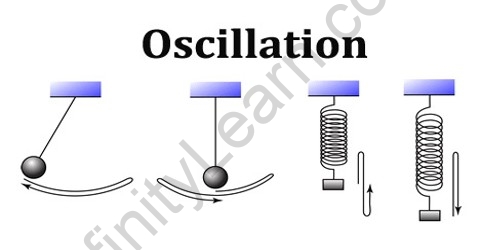Table of Contents
Important Topic of Physics Oscillation: What is oscillation? How do you define it and what are its types. In this article, we shall learn everything about oscillation, its types and examples.
Definition of Oscillation
The repeated back and forth movement of something between two positions or states is referred to as oscillation. An oscillation can be a periodic motion that repeats itself in a regular cycle, such as a sine wave—a wave with perpetual motion, such as the side-to-side swing of a pendulum or the up-and-down motion of a spring with a weight . An oscillating movement occurs when a point of equilibrium or a mean value is approached. It is also known as periodic motion.
Oscillation Process
Oscillation is defined as the process of repeating variations of any quantity or measure in time about its equilibrium value. Oscillation can also be defined as a periodic variation in a matter’s value between two values or about its central value. The mechanical oscillations of an object are described by the term vibration. Oscillations, on the other hand, occur in dynamic systems, or more precisely, in every field of science. Even our heartbeat generates oscillations. Meanwhile, oscillators are objects that move around an equilibrium point.
A single oscillation is a complete movement over time, whether up and down or side to side. An oscillator is a device that oscillates around a fixed point. With each swing of a pendulum clock, potential energy is converted to kinetic energy. Potential energy is at its peak at the top of the swing, and that energy is converted to kinetic energy as it falls and is driven back up the other side. At the top, kinetic energy has dropped to zero, and potential energy is high, allowing the return swing to be powered. To mark time, the frequency of the swing is translated through gears. If the clock is not corrected by a spring, a pendulum will lose energy over time due to friction. Rather than the movement of pendulums, modern timepieces rely on the vibrations of quartz and electronic oscillators.
Also Read: Free, Forced and Damped Oscillations

Examples of Oscillations
The tides in the sea and the movement of a simple pendulum in a clock are two common examples of oscillation. The movement of a spring is another example of oscillation. Oscillations can also be seen in the vibration of strings in guitars and other string instruments. The pendulum swings back and forth, causing an oscillating movement. Mechanical oscillations are referred to as vibrations. When a particle vibrates, it oscillates between two points around its central point. The movement of a spring is also an example of oscillation. The spring moves downward and then upward repeatedly, causing an oscillating movement.
Oscillation is best illustrated by a sine wave. In this case, the wave oscillates between two points centred on a central value. The height or maximum distance over which the oscillation occurs is referred to as the amplitude, and the time required to complete one complete cycle is referred to as the oscillation’s time period. The number of complete cycles that occur in a second is defined as the frequency. The reciprocal of the time period is frequency.
Important Topic of Physics Oscillation in NEET and JEE
Oscillation is an important chapter of Physics for both NEET and JEE exams. It is an easy-scoring topic and students can make the most from it. Mastering the topics like oscillations and waves for NEET and JEE can help you fetch a good score.
FAQs
What exactly is an oscillating motion?
Periodic or oscillatory motion is defined as a motion that repeats itself. Due to a restoring force or torque, an object in such motion oscillates around an equilibrium position.
What exactly is the distinction between oscillations and vibrations?
The main distinction between oscillation, vibration, and simple harmonic motion is that oscillation refers to any repeated variation about a central value, whereas vibration specifically refers to mechanical oscillations.



